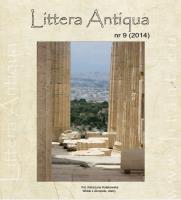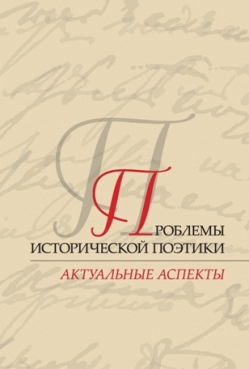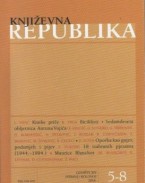
We kindly inform you that, as long as the subject affiliation of our 300.000+ articles is in progress, you might get unsufficient or no results on your third level or second level search. In this case, please broaden your search criteria.


THE PLOT OF HUSBAND’S RETURN TO HIS WIFE’S WEDDING IN "THE ODYSSEY" BY HOMER AND IN THE SLAVIC AND RUSSIAN EPIC
More...
Among the hagiographic works appeared in the 18th century there is a widely-spread “Life of Cornelius of the Vyg” in the Old Believers’ environment. The writing is known in two versions: the original and the literary processed one. The author of the second version is a senior choir singer of the Vyg, Old Believer coenoby Tryphon Petrov. The subject of this article is detection of the artistic peculiarities of his text. The writer made significant alterations to the structure of the text, giving it a three-part format. The main part that is the actual history of the life of Cornelius is divided into chapters, each of which has its name. Along with the text’s structure Tryphon Petrov revised the content of the text too. He eliminated some episodes from the plot and added a number of those non-existing before. Moreover, he introduced topos inherent of the lives of monks and wrote additions aimed at creating the image of the saint. An important part in the work of Tryphon Petrov is assigned to the Vyg community. Cornelius’s spiritual path is represented in the context of its history. Cornelius himself acts as a mediator between the first generation of Old Believers and the residents of the Vyg community. In his image there is embodied the idea of continuity associated with the idea of a special mission entrusted to the community.
More...
Folkloric heroes were turned into characters of literary works of different genres in 18th-century Russian literature. One of them is bogatyr Alyosha Popovich. The distinctive features of the epic hero are such personal traits as astuteness, dexterity, boldness. Vasily A. Levshin perfectly turned to them to pen “Povest’ o Aleshe Popoviche bogatyre, sluzhivshem knyazyu Vladimiru” (A Tale of Bogatyr Alyosha Popovich Serving Prince Vladimir) in his “Russkie skazki” (Russian Tales; 1780—1783). Due to his prankish nature the protagonist performs deeds of valour. He shields the Alanian Kingdom from calamity and makes it a part of the dominion of the Prince Vladimir of Kiev; he defeats the demon Beelzebub acquitting the Polish wizard Tverdovsky of his oaths taken to one of the princes of Hell; he conquers the Tsar-Maiden and takes her to wife. The epic hero becomes a literary character in Levshin’s story. Under going genre transformations he acquires personal traits and appears as the protagonist of the tale that comprises both folk and literary genres.
More...
he article studies the utopia of Prince M. M. Shcherbatov “Journey to the land of Ophir” (1784) in a new literary-historical way. The author explores the pedagogical ideal, represented by Ophir schools. In the centre of the study there are the “small books” containing moral and civil “catechisms”, which are taught in school along with other subjects and illustrate the essence of the Ophirian educational system. There are no special works on “catechisms” despite the fact that they often have been mentioned in academic literature. “Catechisms” are of a particular interest to the history of literature. They reflect not only the fragments of the writer’s biography, his view of modern pedagogical theories, but also describe the image of a man and citizen, the true “Son of the Motherland”. The author analyzes literary sources of “catechisms”, among which there are the works of S. Pufendorf, an Augustinian monk I. Felbiger, “Instruction” of Catherine the Great and writer’s own pedagogical texts. As a result, the author concludes that for Shcherbatov the ideal of school education was strongly connected with the truth of the Christian law.
More...
The article seeks to elaborate a methodological approach to the creative work of Fyodor Dostoevsky, corresponding to dialectical nature of the writer’s artistic world perception. Dostoevsky’s formula “the whole emerges as a hero” is regarded as an architectonic model of his poetics. The author reveals the dialectical and mythological content of various aspects of this model, discovers the moments of community of Dostoevsky’s “realism in the best sense of the term” and Losev’s absolute dialectics. In the light of Losev’s teaching Dostoevsky’s formula is modified according to the dialectical model of a tragic myth. In the structure of the formula there are consistently explicated cosmological, anthropological, Christological, ecclesiological, and pneumatological aspects. These aspects trace back to a number of works of the writer (the novel “Poor People”, the tale “A Faint Heart”, the story “A Little Hero”, the novel “The Idiot”). There is demonstrated the dialectical unity of the intuitions of faith and knowledge in Dostoevsky’s artistic experience.
More...
The author examines similarities and differences in the aesthetic interpretation of the theme of money in terms of social realism of Balzac and Christian realism of Dostoevsky. Such notions as “human mystery”, “a dark side of human nature”, the “ME law”, “the law of love” are introduced to achieve the aforementioned objective. As part of these notions, the article analyzes artistic types and reflection of both writers and shows the equalizing, reducing, transforming and compensating functions of the monetary absolute, which becomes a common equivalent of human freedom and personality and creates conditions for a new inequality. The author reveals anthropologic consequences caused by dominating principles of utilitarianism and monetarist perception, highlighted in the novels by French and Russian writers, that facilitate perversion and inversion of a hierarchy of values, displacement of spiritual and moral fundamentals, mental impoverishment, entropy and nihilism in the degrading society.
More...
The article analyzes Dostoevsky’s novel “The Insulted and Humiliated” in terms of functioning of the prodigal daughter motif in its narrative structure, dating back to the Gospel text and Pushkin’s pretext. The author finds several interpretative variants of the prodigal daughter motif, each one represented by different narrators in various genre models: from a sentimental melodrama (Ivan Petrovich) and a romantic story with a tragic ending (Nelly) to “a charming anecdote” (duke Valkovsky) and an adventure story, stylized of “skomoroshina” (Masloboev). In addition, the text of the novel contains a lyrical story “Bell” by Ya. P. Polonsky, which presents a poetic (romance) version of the traditional motif. In the novel, opening a new period of his works, Dostoevsky appraises the possibilities of a polyphonic art system, using the “eternal story” of the prodigal daughter for that purpose. Analysis of the narrative structure of the novel makes it possible to observe how the author matches different narrative strategies, making the text of the work a kind of “a test area” for creating a new novelistic form.
More...
Konsterniran sam. Prosto, narodski rečeno: šokiran. Nije to stanje trenutka, već konstanta koja će me pratiti do kraja života. Stres za koga današnje društvo nema lijeka. Niti će ga imati u vremenu što mi je na ovome svijetu preostalo. Poklade su dan kada se spaljuju vještice i iluzije. Kada nas maškare uveseljavaju životinjskim izrazima lica i odjećom ovnujskog izgleda. Kada gladni zaboravljaju na glad, a žedni na žeđ. Jer, sutra nastupa vrijeme posta, pa će se manje jesti i piti. I više odricati od svega što nije nužno da bi se slijedio put pokornog bića nazvanog imenom - čovjek.
More...
После напорног преподневног рада у банци реших да одем негде где се може наћи наша домаћа храна, роштиљ на пример, и одем по први пут у кафану изнад чијих врата пише „Лепа Мрена“. Таман седох и уши ми напуни разговор њих двојице који су седели за суседним столом, па сам, хтео не хтео, морао да слушам интересантну дискусију: Је ли, Будалићу, одакле ти оно беше?
More...
Kad se Tasin Bregat vratio iz inostranstva, gdje je bio nedovoljno dugo da zaboravi prolazak kroz tunel ispod aerodromske piste i da se privikne i ostane tamo gdje je bio, ali je potrajalo sasvim dovoljno da mu se usele u stan a njegovu nepraveziđenu sposobnost stenografa da tačno bilježi svaku izgovorenu riječ i naslućuje one koje iza toga slijede, najzad proglase prevaziđenim zanimanjem i da ga ubroje u skrajnute osobe. Ali baš mu to dade priliku da se suoči sam sa sobom, da presabere sve šta je dotad uradio u životu. Dok je tražio duhovnu vezu sa svojim narodom, postao je podstanar. Potražio je rokera Miru koji je prije rata pisao muzičku kritiku.
More...
Mrkla je noć, puna tamne gnjileži i tajni koje žele ostati zauvijek obavijene tminom. Pogodno je vrijeme za svakojake nepodopštine, za zločine, strasti i zavisti; na nebu nema mjeseca, na zemlji nema svjetlosti – sve je crno, propalo, trulo, izgubljeno u opačinama, u razvratu i bludu.
More...
Зна да је тог дана почела да пада киша и да је падала данима. Да је рат почео и да је Ђорђе још био у кући. Никако да дођу та поштанска кола и да му брат крене. У међувремену су стигла два писма из Француске. Отац их је мајци увече читао и она би плакала. Чуо је то из дечије собе. Ништа се није дешавало. Још увек их је осморо седало за сто и толико се дизало. Причало се мање него обично. Рат је почео, а нико у кући није о томе причао, бар не пред њим. Ни школе није било. Ђорђа су исписали још када су мислили да ће за који дан да крене на пут, у ту Француску.
More...
Vjenčanje Marka i Olivere i i njihova svadba, iako skromnija, izazvala je veliko zanimanje javnosti. Posebna pažnja posvećena je grupi gostiju iz Pariza. “Uvažene gospodične Anka i Stanka doputovale su u pratnji naočitog profesora Šarla H. I asistenta Žaka P., te docenta Viktora G. i dve šarmantne studentkinje, koleginice sa fakulteta. Ponosni smo što su naše mlade dame izjavile da će se nakon završetka studija vratiti u rodni Beograd i ovde započeti karijeru, na radost rodbine i prijatelja. Sa prijateljima iz Pariza održavaće kontakt u svrhu stalnog unapređivanja znanja”, zaključio je novinar svoj izvještaj.
More...
Млади соко је чекао у реду, заједно са стотинама других птица. Стајаху сви у парку, шибани вјетром, погледа упртих у величанствену академију копнених летача. Неки зелени као лишће, неки већ пожутјели. Пред њима се у вис дизала колонада мермерних стубова. Клесани капитоли и величанствене глатке степенице, које требаше увјерити све те дуге редове испред академије да су дошли на једно готово свето мјесто. Древна слова натписа бијаху уклесана изнад високог улаза - АКАДЕМИЈА КОПНЕНИХ ЛЕТАЧА. Здање је личило на акрополу, гнијечило је гледаоце својом монументалношћу и наређивало скромност. Узгред, та се институција дичила да вијековима претвара птице свакојаких врста, класа и могућности у праву правцату господу. Са фраковима и шеширима на главама. Стотину двадесет седам генерација прошло је кроз њене величанствене просторије. Једном када би изашли из ње, могли су ходати брзо и ефикасно, без крила која би их спутавала.
More...
Čitava Europa se ubrzano razvijala i modernizovala u drugoj polovini 19.vijeka, ali bosanske kasabe su ostale izvan toga. Bosanci su nastavljali živjeti svojim mirnim životom, istim kakvim su živjeli njihovi očevi i djedovi. Jedan od rijetkih koji je bez razmišljanja odobravao upotrebu svih mogućih novotarija, bio je berberin Junuz. On je bio oduševljen svime novim, što je stizalo iz Europe, i kada god mu se ukazala prilika volio pričati o tome. Danas je u berbernici bilo življe nego inače, jer je bio pazarni dan pa su sve dućandžije i zanatlije imale mnogo više posla.
More...

This article analyzes the interpretations of biblical texts in Dostoevsky’s novel “Crime and Punishment”. It reveals the cases of ambiguity in determining the sources and the character of functioning of biblical allusions and quotations in the novel’s plot, examines the reasons for the textural discrepancies, and determines criteria for studying the biblical text in Dostoevsky’s works. For a more complete and accurate understanding of intertextual relationships, it is important to study biblical intertexts not only on a textual but on plot and figurative levels too, as far as the semantics of certain quotations and allusions is ultimately determined by the characteristics of their insertion into the author’s text and their interaction with the cultural tradition that is represented not only in the biblical text, but in spiritual literature and the folk perception of biblical stories as well.
More...
Dostoevsky’s role in Russian folklore studies has been a research subject both for folklorists and literary scholars for a long time: in criticism, they have determined the range of folklore sources, ideas, genres, plots, motives, topics the writer conveyed in his works. Among his creative inventions we should mention his original conception of the bylina as a folklore and literary genre. In his assimilation of folklore, Dostoevsky exceeded the bounds of the traditional interpretation of folklorism. He was the only one who pointed out such a characteristic of the bylina as contiguity “with the supreme beauty, with the beauty of the ideal”. The bylina expresses “the whole world view of the nation”, “its ideals of heroes, tsars, people’s defenders and patrons, images of valour, humility, love and sacrifice”. Relying on the folklore conception, Dostoevsky developed his conception of the bylina as a literary genre that could express the meaning of Russian history, the Russian outlook on life, the Russian idea. There are no bogatyrs in his bylinas, but there are feats of ordinary people. They comprise the pivotal moments and landmark events of Russian and world history when Christianity was changing and the Russian futurity was emerging. In his opinion, such bylinas from Russian history “could be a great national book”, “could favour the revival of the Russian man’s self-consciousness”. Dostoevsky did not attain his aim; he only developed the conception of the genre and gave its literary example having enunciated the content of one of the bylinas in details. He passed his conception onto poet Maykov who could not implement their general creative idea. Despite the fact that there was no creative result, critics and poets should pay attention to the Dostoevsky’s conception of the bylina as a genre invention of the writer.
More...